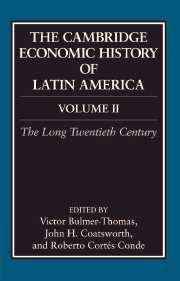Book contents
- Frontmatter
- Introduction
- Part I Cycles of Globalization
- Part II Onset of Modernization
- 5 The Institutional Framework
- 6 Fiscal and Monetary Regimes
- 7 Export-Led Industrialization
- 8 The Development of Infrastructure
- Part III Factor Endowments
- Part IV Sectoral Development and Equity
- Bibliographical Essays
- Index
- References
6 - Fiscal and Monetary Regimes
from Part II - Onset of Modernization
Published online by Cambridge University Press: 28 March 2008
- Frontmatter
- Introduction
- Part I Cycles of Globalization
- Part II Onset of Modernization
- 5 The Institutional Framework
- 6 Fiscal and Monetary Regimes
- 7 Export-Led Industrialization
- 8 The Development of Infrastructure
- Part III Factor Endowments
- Part IV Sectoral Development and Equity
- Bibliographical Essays
- Index
- References
Summary
MODERNIZATION FROM THE END OF THE NINETEENTH CENTURY TO WORLD WAR I
Throughout Latin America, the formation of national states in the last decades of the nineteenth century went together with the growth of their economies. Wars and political conflicts ended, isolation was mostly overcome thanks to new transportation technologies, and central governments became stronger. This process coincided with the modernization of political and economic institutions and included the creation of new fiscal and monetary institutions. Public finances and tax administration were reordered. Anachronistic taxes on production and local trade were dropped, and states financed themselves increasingly through indirect taxes such as duties on foreign trade (especially on imported consumer goods). This became possible because Latin American economies were oriented toward foreign markets. Enjoying control of rising customs revenues, central governments consolidated their power. In years when peace prevailed, the role of the armed forces diminished and war expenditures declined. Thus, expenditures grew on items related to economic development, such as subsidies, public works investment, railways, and education. Administrations still suffered the consequences of prior wars in the form of high debt burdens. There were efforts to tap foreign capital markets and to create domestic ones although those efforts suffered from widespread suspicion about the governments’ arbitrary procedures. Governments proceeded to monetize their debts through private or mixed banks established during the economic boom. In other cases, treasuries issued money directly.
- Type
- Chapter
- Information
- The Cambridge Economic History of Latin America , pp. 209 - 248Publisher: Cambridge University PressPrint publication year: 2006
References
- 3
- Cited by



